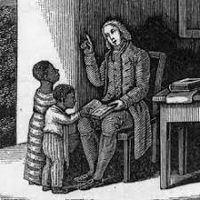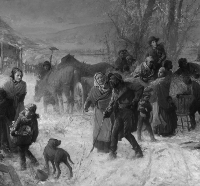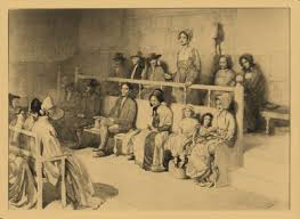Quakers: the Society of Friends
Another way in which Quakers set themselves apart from others was in the names of the days of the week and the months of the year. Rejecting the traditional names, which they considered pagan, Quakers referred to Sunday and First Day, Monday as Second Day, and so on, with the end of the week being Seventh Day. In the same way, the calendar year began with First Month. This so-called "plain calendar" originated in the Puritan movement but was adopted early on by the Friends as well. The Society of Friends grew in membership despite the threat of state punishment. Among their other beliefs that political and religious leaders found troubling were these:
In addition to the 1662 Quaker Act, which accompanied the Act of Uniformity making the Church of England Book of Common Prayer as compulsory in all English religious services, Parliament passed the Conventicle Act, a 1664 statue that forbade religious meetings not associated with the Church of England. Parliament relaxed such restrictions in 1689, after the Glorious Revolution had resulted in new monarchs William and Mary. In the meantime, however, many Friends were prosecuted and imprisoned, including Fox. The first Quaker missionaries–including Ann Austin, Mary Fisher, and Elizabeth Harris–went to North American in 1656. There, they found the same kind of persecution that they endured in England. In fact, four Quakers were executed in Massachusetts in 1600 for violating a law that specifically prohibited them from practicing their beliefs. King Charles II stopped executions of this nature, and the Crown later required the colony to implement a Toleration Act. More Quakers went to North America. Some of them set up a meeting house in what is now Monmouth County, N.J., in 1672. Fox visited this meeting house in that year. Quakers lived in more and more colonies, notably Rhode Island, as the 17th Century progressed. 
Things changed when William Penn arrived. Penn, who had joined the Friends in 1666, had obtained a royal charter from King Charles II to settle a large amount of land in North America that the king named Pennsylvania, in honor of Penn's father, who was also named William. Penn himself was arrested several times in England before making the journey to North America in 1682. Penn's Frame of Government in the new settlement envisioned a two-house parliament, which would be tasked with protecting the Sylvania residents' right to privately own property, worship the way they wanted to, have a free and fair jury trial, and freely elect their leaders. In addition, any taxes were to be fair to those having to pay them. It was a true framework for democracy. Some beliefs put Quakers at odds with many in North American as settlement of that continent grew. The Friends did not believe in the exploitation of animals and opposed the fur trade that dominated the economy of the 1700s and 1800s. They did not believe in taking up arms against other people, and this put them at odds with many others in North America at the outbreak of both the French and Indian War and the Revolutionary War (although many Quakers served in a medical capacity during the wars). When the latter war began, in the mid-1770s, some Quakers formed their own groups, known as Free Quakers or Universal Friends, in order to be able to support the war effort. One Philadelphia-based group included the famous seamstress Betsy Ross. Members of the Friends did agree with the American colonists who spoke out against the Stamp Act and other taxes designed to recover French and Indian War debt. The Friend, however, preferred to pursue nonviolent means of protest, such as nonimportation, rather than resorting to violence, which, to their way of thinking, including boycotts. One well-known Quaker supporter of the resistance of taxes was John Woolman, who was born in New Jersey and first found work as a tailor but later found a calling as a missionary and traveled throughout the 13 Colonies, spreading the message of the Friends. Woolman opposed slavery as well and went out of his way to avoid eating any food or wearing any clothes that were the result of slave labor.  Another Quaker leading the movement against slavery was Anthony Benezet, who took things to the next level. He was the first person to write an English-language history of West America. He opened a Quaker-run school for African-Americans (not long after opening a Quaker-run school for girls). He spoke out against the idea that African-Americans were inherently inferior to European-Americans. In 1775, Benezet formed the first American antislavery society, the Society for the Relief of Free Negroes Unlawfully Held in Bondage. (Benjamin Franklin was later president of this group.) 
The Quakers were some of the first in North America to call for the abolition of slavery. One of the earliest antislavery tracts written in North America came in 1693, from the hand of George Keith, who was involved in a high-profile religious quarrel with Penn and the Philadelphia Quakers for a time. In 1696, the Friends had declared the opposition to the slave trade. The Friends were also known for supporting and participating in the Underground Railroad. Well-known Quakers associated with that series of escape routes for runaway slaves included Levi Coffin, Paul Cuffee, and Laura Smith Haviland. The Quakers' steadfast resistance to the idea and the practice of slavery inspired later abolitionists such as William Lloyd Garrison. The Friends also abstained from drinking alcohol and joined the Temperance movement in the U.S. Many in the women's suffrage movement were associated with the Temperance movement as well. Noted leaders of the women's suffrage movement who were also Quakers included Lucretia Mott and Alice Paul. Membership in the Friends grew as the centuries progressed, and Friends lived in countries around the world. As of 2017, the number of Friends worldwide exceeded 377,000. They made a point of not fighting in the various wars and conflicts that punctuated the 19th Century and 20th Century; repeating the Revolutionary War experience, however, many joined the medical corps of the nations in which they lived. As far as taking roles in combat, though, they remained conscientious objectors. The prominent Quaker Eric Baker had a role in the founding of Amnesty International and the Campaign for Nuclear Disarmament. Another prominent Quaker, Edith Pye, set up the Famine Relief Committee, which became Oxfam. Also during the 19th Century and 20th Century, other splits in membership occurred. As well, some Quakers shook off the early avoidance of pursuing capitalism and became prominent businessmen. Among famous businesses founded by Quakers were Barclays Bank, Lloyds Banking Group, Cadbury chocolate, Huntley & Palmer's biscuits, and Clarks shoes. Two American Presidents, Herbert Hoover and Richard Nixon were Quakers. |
|
Social Studies for Kids
copyright 2002–2025
David White



 People could gather anywhere to share in a religious meeting. (They usually had regular rooms or buildings in which they met, but these were not called anything but meeting rooms.) A meeting could be two or more people. The idea was to create an internal silence in order to be in touch with the inner light. The practice was to wait quietly until inspired to speak. Both men and women, who were equal in the eyes of God, could speak during such meetings.
People could gather anywhere to share in a religious meeting. (They usually had regular rooms or buildings in which they met, but these were not called anything but meeting rooms.) A meeting could be two or more people. The idea was to create an internal silence in order to be in touch with the inner light. The practice was to wait quietly until inspired to speak. Both men and women, who were equal in the eyes of God, could speak during such meetings.
